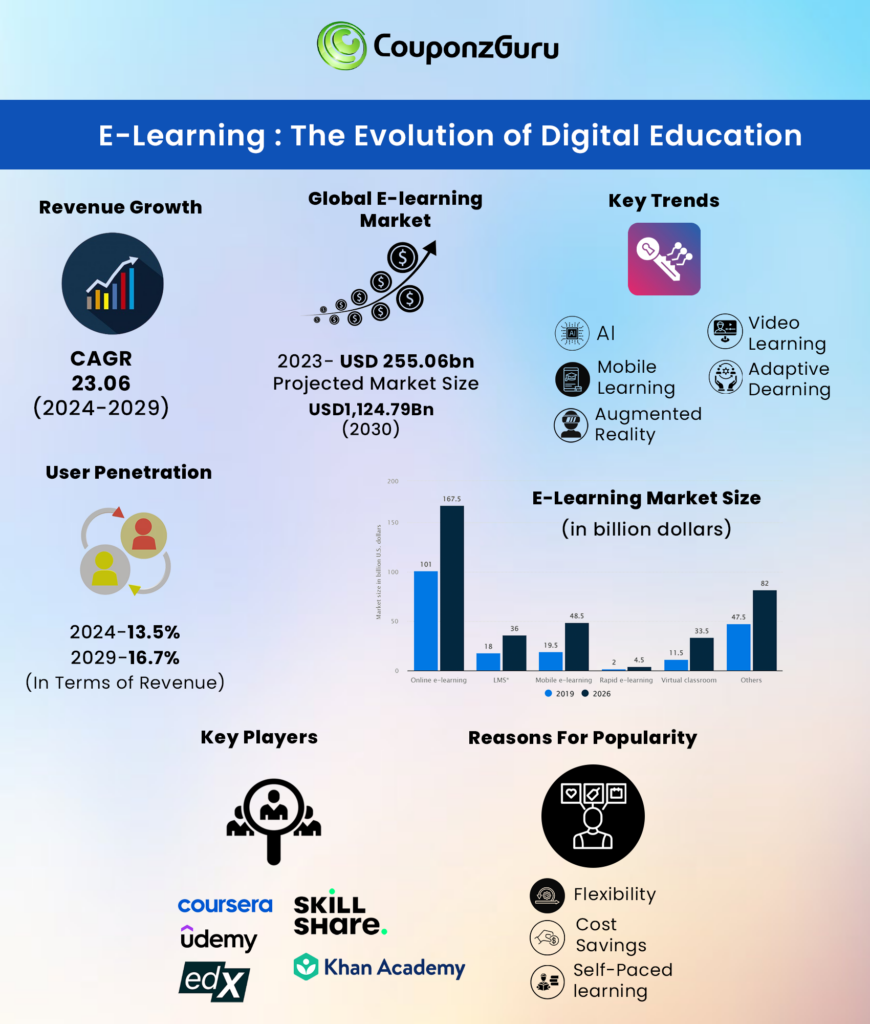
E-learning has experienced exponential growth over the past decade. This growth is being driven by several factors including advances in technology, changing educational needs, and the availability of high-speed internet. This article is all about the current trends shaping the e-learning landscape while examining key statistics and factors contributing to its rise. Read the article and learn about the the evolution of digital education.
Revenue Growth and Market Size
To start with, we will explore the revenue growth and the market size of the e-learning platforms. The global e-learning market has witnessed substantial revenue growth in recent years. The global market is growing at the rate of CAGR 23.06% valued at approximately $255.06 billion in 2023 and is expected to reach over $1,124.79 billion by 2030.
This growth is the result of the increasing adoption of e-learning solutions across various sectors, including education, professional development, corporate training, and more.
Key Trends in e-learning
Several key trends are driving the evolution of digital education
- Artificial Intelligence
Today most platforms analyze user data to tailor educational content and recommendations based on people’s learning styles and progress. These are all carried out by the advances in machine learning.
2. Mobile Learning
Mobile learning has made it easier for students to learn even on the go. They can access educational content anytime, anywhere. One can engage in learning activities, take lectures, and understand basic concepts with the help of mobile phones and tablets.
3. Augmented Reality
Augmented reality is one of the major key trends of e-learning these days. It helps in creating engaging and interactive learning experiences that increase technical skills.
4. Video Learning
When we talk about the evolution of digital education, Video learning is without a doubt the best form of the same. It enhances user experience and makes the learning even more engaging. Video lessons are easier to understand as well and this is why the demand for video lectures is growing every day.
5. Adaptive Learning
The last key trend in e-learning is adaptive learning which allows more accessible and flexible learning opportunities for individuals who don’t have access to the traditional form of learning.
User Penetration
According to Statista, as of 2024, there are over 2.5 billion e-learning worldwide users. This includes students, professionals, and life-long learners who access educational content through various online platforms and applications. If we talk in terms of revenue, during 2024 it’s just 13.5% which is projected to reach around 16.7% by the end of 2029.
E-Learning Market Size (In Billion Dollars)
The above graph shows the e-learning market size. Read below to learn more-
The worldwide e-learning industry has seen drastic expansion from 2019 to 2026 (Source-Statista)
- Online e-Learning- In 2019, it was around 101 billion dollars and by 2026 this is expected to reach 167.5 billion dollars.
- LMS- During 2019, that is pre-COVID, the LMS was noted to be 18 million dollars which is projected to reach around 36 million dollars by 2026.
- Mobile E-learning- Pre pandemic era didn’t see anything like mobile learning as the classes and lessons used to be in person. So, it was around 19.5 billion dollars in 2019 worldwide. While it is expected these figures will become 48.5 by 2026.
- Rapid E-learning- This was just 2 billion dollars in 2019 but is expected to grow and become 4.5 billion dollars by the end of 2026.
- Virtual Classroom- Virtual classrooms were not that big of a concept before the pandemic and the figures were 11.5 billion dollars and are expected to be 33.5 billion dollars by 2026.
Key Players
The key players are mentioned below-
Coursera

Coursera collaborates with premier educational institutions as well as other establishments globally to impart numerous courses, specializations, and degrees. Millions around the globe can access quality education through it. By the end of 2024, there will be more than 124 million registered users on Coursera. Popularity due to the diversity of courses offered through this platform exists in areas such as data science, business, or personal growth.
Skillshare

Educative and creative are two words that can be used to describe Skillshare. The website provides access to topics including design, illustration, photography, and writing courses among others. This is ideal for individuals looking to improve their artistic abilities through brief lesson projects. Currently, the platform has approximately 12 million users. The site promotes peer evaluation as well as group tasks fostering a sense of belonging.
Udemy

Udemy is among the biggest online learning platforms, featuring more than 213,000 courses covering a wide range of subjects such as technology, business, personal growth, and art. It has gained popularity among its users as it allows them to learn at affordable costs with a huge number of choices. Apart from that. The platform also serves over 57 million students worldwide which places it at the top of the list. The platform is known for offering ample courses including languages, Finance and Accounting, IT& Software, Digital Marketing, and many more categories.
edX

edX is a nonprofit platform established by MIT and Harvard that offers high-quality courses from leading universities and institutions globally. It provides free and paid courses with an emphasis on professional growth, adult education, and life-long learning. In 2024, edX boasts above 45 million users.
Khan Academy

Khan Academy is a free educational platform for K-12 education that offers courses, mainly in mathematics, science, economics, history, and so on. This platform is most often used by students, teachers, and parents as an extra tool for education apart from the traditional school system. More than 140 million people signed up as of 2024. This shows how much it has been embraced all over the world regardless of age or race in terms of education.
Reasons for the Popularity of E-Learning Platforms
- Flexibility and Convenience
- Wide range of courses
- Cost-effective learning
- Personalized learning
- Global accessibility
- Engaging content
- Collaborative learning, and more.
Conclusion
In a nutshell, the evolution of digital education symbolizes the most radical change as technology advances and societal demands change. The use of interactive platforms that allow for custom-made learning experiences around the world has transformed education delivery and consumption. Looking ahead, it is important that we keep up with these developments but also work on issues such as digital equity and learner engagement.
